In defense of monotony
We might howl in reply, but out of monotony’s patient darkness, new life.
A few weeks ago, while clearing closet clutter to make space for a new printer, I unearthed a half-finished project, a craft I had poured myself into for two years before abandoning it for other pursuits. Needle felting had never called to me, hadn’t even crossed my mind, until life stripped me bare. I didn’t search for it; it found me, in the aftermath of developing Mal de Débarquement Syndrome (MdDS)—a neurological disorder that manifests as a constant, dizzying perception of rocking, bobbing, or swaying. I was in the throes of chasing a cure, a fix, a way out, but when suffering’s source is within, where, truly, can one escape? Normal distractions failed me. Screens were nauseating, music too loud, books too bouncy. Even heading for the hills left me an anxious mess, my balance system a broken compass navigating a constant life at sea.
In a 6’ x 6’ kitchen-nook womb, I insulated myself against the life I’d known and waited. First, swaddled in darkness, then eventually, wool. What emerged on the other end of thousands of hours of poking and prodding balls of fluff were thirteen hairless cat sculptures. Little did I know, they were sculpting me in return.
An unused Christmas gift—Beginner’s Guide to Needle Felting—invited me into a new, lasting distraction. Needle felting: an art as rudimentary as it is absorbing. Again and again, I’d pierce wool with sharp, barbed needles, matting formless fibers into shape. Perhaps it was the quiet rhythm of the work, or the muffled warmth of wool in hand, but I lost myself in it, each day blurring into weeks, then months, then years. To form a firm cat ear, life-sized and dense, might take four hours of mindless poking; an entire cat, four months. The cushion beneath me didn’t stop bobbing and swaying but that needle, that wool, they held steady, grounding me in each soft poke. I couldn’t stop.
Needle felting threw me a lifeline just as I was about to go under. Each felted shape breathed flesh into the thin-skinned vulnerability I couldn’t voice and no one could see. Each creature, a wordless chapter in my uncertain story, their naked curves mirroring my fragility. They spoke of hibernation, cocooning, and itches they couldn’t scratch. Grumpy, hopeful, then grumpy again, they spat up hairballs and yowled through the night but never doubted the balancing light.
Yet inseparable from the craft, it was really monotony that saved my life. A steady mother figure, monotony was patient and generous when I was nothing but toward my symptoms. Vanished inside thousands of hours of repetitive movement, I forgot to be lonely and heartbroken for the loss of my life. I forgot to think about the implications of my disappearance from the world. Did my mind wander? Sure. Did the dizziness leave? Not a chance. But like an inside-out tornado, monotony’s quiet eye surrounded my whirling brain with stillness.1 Resting inside wooly darkness, resistance faded; longing disappeared; past and future dissolved into the millisecond-motions of my hands. Monotony showed me how to hold my brokenness. And through the slow metabolism of uncertainty, her enduring embrace cradled me and the cats until, finally, my love for their vulnerability was no different than the love I would offer my own.
There were no epiphanies, not immediately. I only offered myself to the task at hand. Many extol boredom and monotony as pathways to self-discipline and mastery, that great breakthroughs are born from tedium. But I’m not here to champion monotony for success. There are countless self-help books for that. A simple google of the word and I’m overwhelmed with tips on “How to break free from monotony” or conversely, “Monotony as midwife to mastery.” I didn’t throw myself into needle felting to perform my “ten-thousand hours” and master the craft. I did it to save myself, not some future self, but my present self, moment by dizzy moment. The epiphanies were cellular and beyond cognition, the slow-moving hands of time massaging me toward deep, unbidden surrender.
To give ourselves to a repetitive task is to become animal, to move in rhythm with inner clocks that gently nudge us along cycles of becoming and undoing. Our ears evolved to catch rhythm; our eyes to seek pattern. My hands poke wool while the flickers peck while the cats lick while the water flows while the skies give while the ground receives while the seasons turn all inside infinity’s gaping mouth of indifference.
The dictionary tells us monotony is “wearisome sameness, tiresome uniformity, or lack of variation,” with no olive branch offered to its uses, no nod to its nature. Monotony is dull, tedious, repetitive, and GOOD-GOD-BORING. And I get why we dread it so much, monotony is the mother of mortality, the relentless drumbeat beneath life’s inevitable quiet of dissolution. She is the inhale but also the exhale, each second a little death. There—you just experienced one too. Oops. And another. Each breath a cliff, and we cling to it, mistaking novelty and excitement for immortality. So be forewarned as you plan your next great adventure, British philosopher and logician Bertrand Russell offers, “Too much excitement not only undermines the health, but dulls the palate for every kind of pleasure, substituting titillations for profound organic satisfactions, cleverness for wisdom, and jagged surprises for beauty… A certain power of enduring boredom is therefore essential to a happy life.”
Might Russell be right? Could it be that by surrendering to rhythmic routine we expand into deep contentment and joy? This defies everything our culture shouts at us, where shiny, stimulating, and new sit central on the altar of happiness. In her review of Russell’s The Conquest of Happiness, writer Maria Popova speaks to the magic of renunciation, suggesting that monotony reveals our truest truths:
Russell called it “fruitful monotony.” Adam Phillips called it “fertile solitude.” Walt Whitman called it “loafing.” The Buddhist tradition describes it simply as presence. Amid a culture bent on productivity and dopamine-laced distractions, to enact such stillness is an act of courage—a state in which our inner voice becomes audible, the voice with which we sing the song of our lives.
Nature knows this song well. Pattern, rhythm, cycle, season and fractal all harmonize in a metronomed symphony. Outside my window, the same sparrows peck at the same feeder they’ve visited for half a year. Do they tire of their routine? Do trees grow weary of shedding? Does the earth dread its endless spinning? Or do they simply carry on, joyfully strumming strings fastened between dark and light, emptiness and possibility? The mother of death and life alike, monotony is as faithful to creation as she is to decay. Her patience, our endurance. Like the methodical poke and prod of the needle, she holds the universe in her hands, nurturing and dismantling, birthing and burying.
We might howl in reply, but out of monotony’s patient darkness, new life.
I wonder, Is what we call monotony merely a failure to notice this endless renewal? Colorlessness, invariability, tedium—who made it so? Isn’t each sunrise and set filled with subtlety? Your every breath a unique murmuration spiraling in and out of lungs? Colorlessness surely isn’t without color. Invariability under a microscope teems with life and vigor. Our calendars display routine but your every moment is its advent of inventiveness.
Susan Sontag expands on our perceptual shortcomings in her diary, As Consciousness Is Harnessed to Flesh: Journals and Notebooks:
"Boredom is a function of attention. … if we become bored, we should ask if we are operating in the right frame of attention. Or—maybe we are operating in one right frame, where we should be operating in two simultaneously…”
Oh how we’ve grown deaf in monotony’s presence! But through willing immersion we might hear once again: dismissing tedium as failure of circumstance, relearning attention, and opening at last, to the song hidden, even unbidden, within. Practicing musical scales leads to mastery, and mastery invites improvisation. Needle felting helped me brave monotony’s mind-numbing depths so I could hear new notes—kinder, more curious, more compassionate notes—at the bottom of my measured abyss.
Stirred to listen again, I bring my abandoned sculpture from the closet, wipe years of dust and memory from a bin of wool, and spend a Sunday reclaiming the small ritual of repetitive, unhurried acceptance. My senses rise up to meet the familiar touch, the soft nibbling sound of needle against wool, the scent of warmth filling my nose. Each gentle movement gives form and softens my need for it. I poke and poke and poke until the afternoon collapses, a dying star in my hands; time, dizziness and self pull toward its quiet center. Surrendering to monotony’s rhythm once again, I know she is here, watching over both my labor of creation and my unraveling, reminding me how to live and love inside each enduring motion. She reminds: keep going, keep tending, hold life, and it let go.
Stillness expands and I bow to her origin.

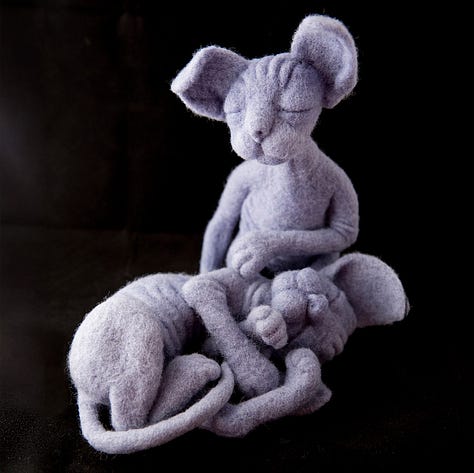
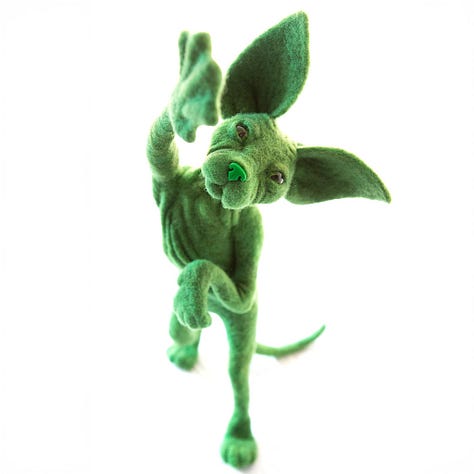
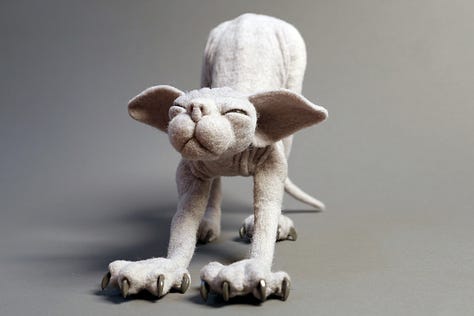
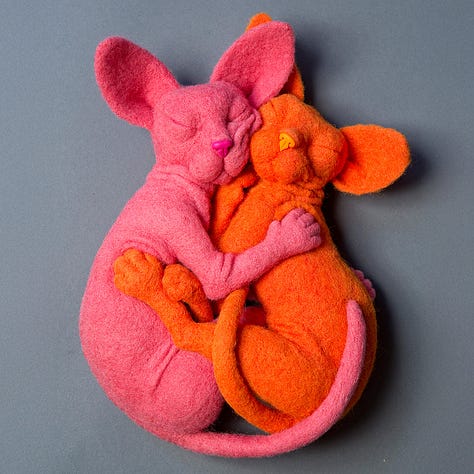
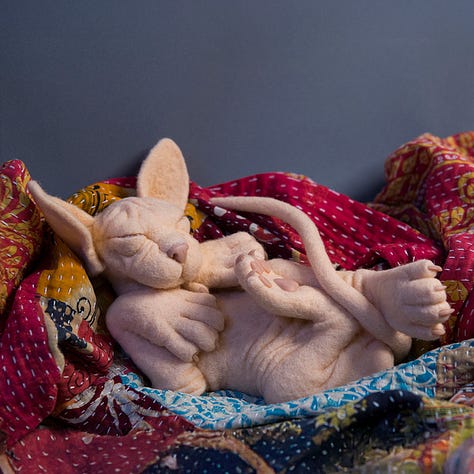
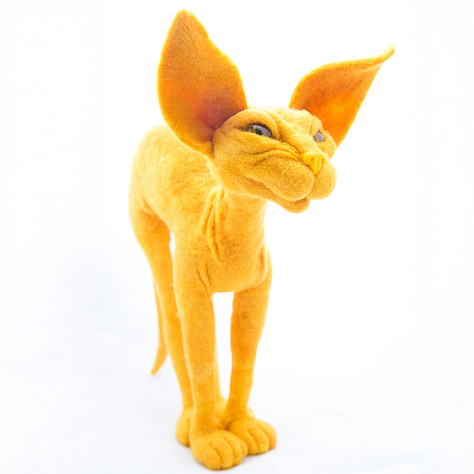

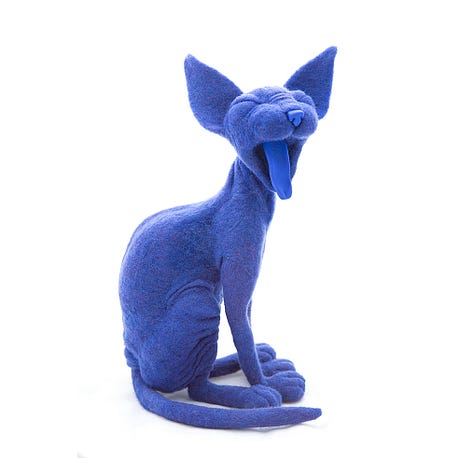
Visual artist and writer
recently wrote a wonderful essay about boredom and monotony, explored through her painstakingly slow, repetitive painting techniques that convey the flowing complexity of time. We both discovered a still point born from repetition and boredom, but she describes hers as 'the center of the whirling world,' whereas my experience is the opposite: stillness embracing my inner whirling."


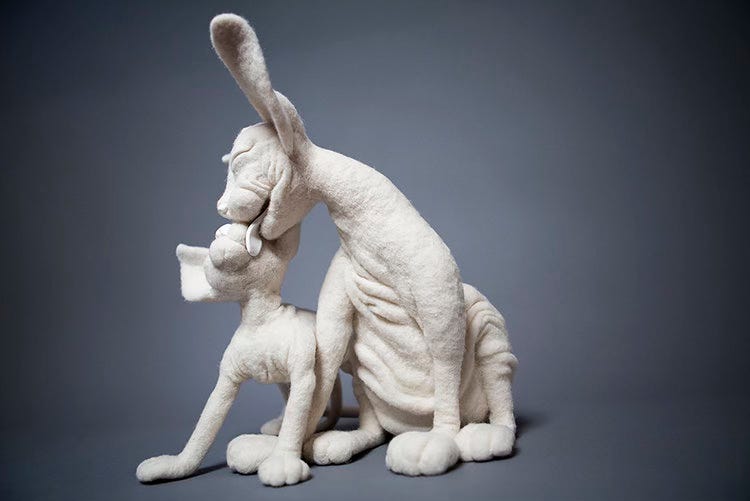
Your cats Kimberly! They are the most exquisite things I want to pick up and squidge and hug and just stare at forever! I can't even imagine how many hours of work and concentration you must have put into each one... I would be incapable.
I think if I were diagnosed now in the manner many of my students are, the results would ring a resounding ADHD and/or HA disorder. I find being still an almost unbearable agony (even more so recently with all that star dust prickling my skin) monotony is a word that terrifies me.
And yet, as I read you beautiful phrases praising this very thing I am so scared of, I can see much sense... I can see I am in need.
"Each gentle movement gives form and softens my need for it. I poke and poke and poke until the afternoon collapses—a dying star in my hands; time, dizziness and self pull toward its quiet center."
I have pasted this time screen - a reminder for every time I feel I've sat too long. X
I have so much to say about this amazing essay. First of all, I am speechless at the craft of your writing Kimberly. There are so many beautiful sentences I read over and over in awe of how you strung the words together. It is beautiful!
Even more beautiful is your offering, the gentle holding out of your hands to say 'look here Dear One, look at what repetition can offer your soul.' This gift comes at the perfect time, as these things do. I am heading into a season of grey monotony that is Canadian winter. It will be filled with repetition - and joy and beauty of course.
Thank you for sharing your creations with us. These are NOT the cats I was picturing in my mind as I was reading!! Your cats are works of art, I love them.